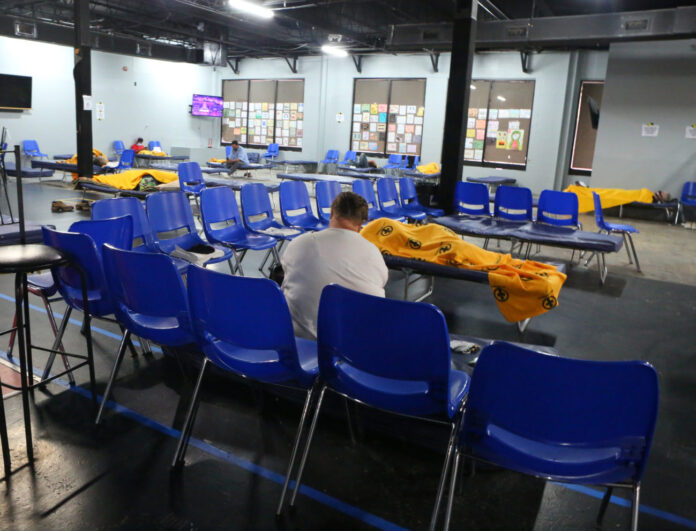There’s 2020, and then there’s 2020 in the Rio Grande Valley, where devastation has struck on two fronts in a perfect storm of disaster — all before summer’s end.
While no one in the Valley needs a reminder that the area has endured a pandemic of biblical proportions for more than a month, things became shockingly worse Saturday as the region incurred a storm that only added to the suffering. Leaving some to wonder when the hordes of locusts and frogs and boils will arrive, and how long the people of the Valley can endure the torment of a year that doesn’t give The Monitor much opportunity to print good news.
Whether by coincidence or fate, Hidalgo County Judge Richard F. Cortez said a “tsunami” was coming long before Hurricane Hanna rained down a torrential downpour on the Valley for what seemed like an eternity Saturday evening. A deluge that for the fourth time in nearly as many years flooded our communities, and left structural damage and power outages affecting thousands in its wake.
At that time, March 31, the judge was referring to COVID-19 and the challenges that he knew lay not far ahead for the region. He’s since delivered that ominous warning on several more occasions, at times begging the public and the state for help in mitigating the spread of the disease.
Between now and then, lockdown measures that at one point seemed to slow infections were lifted by the state. Holidays rolled around, and cases have skyrocketed by nearly 600% in about a month’s time, with so many deaths now that the bodies of Valley residents rest in refrigerated trucks, hospital morgues and funeral homes in alarming numbers.
The remains of at least one such individual was found inside his home late Saturday evening amidst the hurricane, a man who found himself in the eye of both storms, and the victim of one of them.
Now the region is on its knees again, this time wading through floodwater, looking for a way out of a storm that’s testing a historically resilient community that has survived devastation before, in the forms of Hurricanes Beulah and Dolly, but hasn’t faced one when crippled by a pandemic.
There are 231 people in Hidalgo County fighting COVID-19 in intensive care units. The Valley, it seems, needs intensive care as well.
Even the minimal damage Hanna brought with her Saturday is potentially life-threatening to an already-vulnerable region, which has for weeks been holding its breath for a field hospital or an army of nurses or a miracle — anything that could substantially relieve our healthcare institutions overwhelmed with coronavirus patients and the bodies of those who never recovered.
The Valley awaits the state’s help on that front. Meanwhile, rescue crews and officials and residents are scrambling to pick up the pieces while simultaneously attempting to social distance, fearful that helping one another — the silver lining during the region’s previous hurricanes — may also turn deadly.
Therein lies another dilemma: Hanna can still kill due to COVID-19 complications.
Power outages, for instance, are not an inconvenience. They’re a threat that could kill the unprecedented amount of people relying on emergency medical equipment. High winds and flooded roads do the same, grounding ambulances and slowing doctors and nurses from reaching their patients.
Having COVID-19 at home is dreadful, surely. Having COVID-19 at home, in the dark, alone, while the sheets of rain pelt your roof and tree limbs fall outside and the water creeps up the driveway is the stuff of nightmares.
Already, Hidalgo County alone has incurred hundreds of virus-related deaths, casualties to a disease that has claimed 149,000 in the U.S., 5,002 in Texas, and 456 in the Rio Grande Valley — people who, if not for the coronavirus, would be waking to another form of devastation Sunday morning with their neighbors.
Meanwhile, as Valley residents fear another tsunami taking shape, local emergency management officials have opened nine shelters in Hidalgo County, which were at capacity by Saturday evening with space so limited that at least one family had to sleep inside a local police station’s hallway.
Two-hundred water rescues, with more necessary, were already conducted by midday Sunday, with reports of heavy flooding in Edinburg, the Mid-Valley, Mission and much of Hidalgo County.
In Edinburg, specifically, police there reported more than 250 calls between 6 p.m. Saturday and 11 a.m. Sunday, responding to nine accidents involving 18-wheelers, three of which were rollovers on U.S. Highway 281, as most major intersections remain underwater.
There were downed electrical wires, over 50 water rescues, and the police department itself in Edinburg sustained damage to its roof, with water leaking into the building.
There were little inconveniences too — broken flower pots, damaged cars, mighty old trees ripped down in the front yard. Not being able to make a cup of coffee Sunday morning because the power never came back on.
Little inconveniences, but the latest in a string of trials and tribulations every person in the Valley has put up with for most of 2020. More little hardships added to the ledger of a very hard year.
Such was Hanna’s fury Saturday that it also knocked out the power at The Monitor’s and Valley Morning Star’s McAllen and Harlingen offices, delaying the print production of their Sunday editions in addition to The Brownsville Herald — newspapers which would have otherwise shown tangible evidence that morning of these times, with eight pages of obituaries and dozens more death notices combined.
Readers can still view them via the newspapers’ online editions, available at their respective websites — themonitor.com, brownsvilleherald.com, and valleymorningstar.com.




